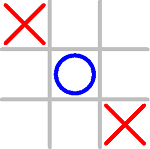 /* A simple Tic Tac Toe game. */
/* A simple Tic Tac Toe game. */#include <stdio.h>
#include <stdlib.h>
char matrix[3][3]; /* the tic tac toe matrix */
char check(void);
void init_matrix(void);
void get_player_move(void);
void get_computer_move(void);
void disp_matrix(void);
int main(void)
{
char done;
printf("This is the game of Tic Tac Toe.\n");
printf("You will be playing against the computer.\n");
done = ' ';
init_matrix();
do{
disp_matrix();
get_player_move();
done = check(); /* see if winner */
if(done!= ' ') break; /* winner!*/
get_computer_move();
done = check(); /* see if winner */
} while(done== ' ');
if(done=='X') printf("You won!\n");
else printf("I won!!!!\n");
disp_matrix(); /* show final positions */
return 0;
}
/* Initialize the matrix. */
void init_matrix(void)
{
int i, j;
for(i=0; i<3; i++)
for(j=0; j<3; j++) matrix[i][j] = ' ';
}
/* Get a player's move. */
void get_player_move(void)
{
int x, y;
printf("Enter X,Y coordinates for your move: ");
scanf("%d%*c%d", &x, &y);
x--; y--;
if(matrix[x][y]!= ' '){
printf("Invalid move, try again.\n");
get_player_move();
}
else matrix[x][y] = 'X';
}
/* Get a move from the computer. */
void get_computer_move(void)
{
int i, j;
for(i=0; i<3; i++){
for(j=0; j<3; j++)
if(matrix[i][j]==' ') break;
if(matrix[i][j]==' ') break;
}
if(i*j==9) {
printf("draw\n");
exit(0);
}
else
matrix[i][j] = 'O';
}
/* Display the matrix on the screen. */
void disp_matrix(void)
{
int t;
for(t=0; t<3; t++) {
printf(" %c | %c | %c ",matrix[t][0],
matrix[t][1], matrix [t][2]);
if(t!=2) printf("\n---|---|---\n");
}
printf("\n");
}
/* See if there is a winner. */
char check(void)
{
int i;
for(i=0; i<3; i++) /* check rows */
if(matrix[i][0]==matrix[i][1] &&
matrix[i][0]==matrix[i][2]) return matrix[i][0];
for(i=0; i<3; i++) /* check columns */
if(matrix[0][i]==matrix[1][i] && matrix[0][i]==matrix[2][i])
return matrix[0][i];
/* test diagonals */
if(matrix[0][0]==matrix[1][1] &&
matrix[1][1]==matrix[2][2])
return matrix[0][0];
if(matrix[0][2]==matrix[1][1] &&
matrix[1][1]==matrix[2][0])
return matrix[0][2];
return ' ';
}
Download Game:-












.png)
.jpg)

.jpg)
.jpg)

.jpg)
.jpg)
.jpg)
.jpg)

.jpg)
.jpg)


.jpg)









.jpg)

